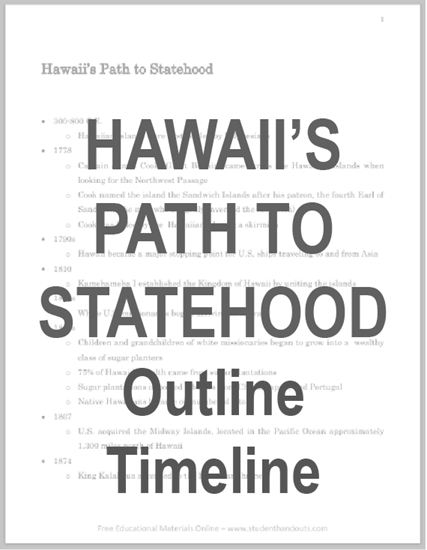| Hawaii's Path to Statehood |
| www.studenthandouts.com ↣ Geography ↣ Northern America ↣ U.S.A. ↣ Western USA ↣ Hawaii |
| Free Printable History Outline-Timeline Worksheet for Grades 7-12 - Scroll Down to Print (PDF) |
 |
 |
|---|
|
300-800 C.E. Hawaiian Islands were first settled by Polynesians 1778 Captain James Cook (Great Britain) came across the Hawaiian Islands when looking for the Northwest Passage Cook named the island the Sandwich Islands after his patron, the fourth Earl of Sandwich (the man who allegedly invented the sandwich) Cook was killed by the Hawaiians during a skirmish 1790s Hawaii became a major stopping point for U.S. ships traveling to and from Asia 1810 Kamehameha I established the Kingdom of Hawaii by uniting the islands 1820s White U.S. missionaries began arriving in Hawaii 1840s Children and grandchildren of white missionaries began to grow into a wealthy class of sugar planters 75% of Hawaii's wealth came from sugar plantations Sugar plantations imported laborers from China, Japan, and Portugal Native Hawaiians became outnumbered 3 to 1 1867 U.S. acquired the Midway Islands, located in the Pacific Ocean approximately 1,300 miles north of Hawaii 1874 King Kalakaua ascended to the Hawaiian throne 1875 King Kalakaua signed the Reciprocity Treaty with the U.S. Hawaii could sell duty- and tax-free sugar to the United States U.S. could build Pearl Harbor naval base on the Hawaiian island of Oahu 1877 White group known as the Honolulu Rifles forced King Kalakaua to sign the Constitution of the Kingdom of Hawaii Hawaii became a constitutional monarchy Suffrage only for non-Asian males, at least 20 years old, who owned property 1890 McKinley Tariff repealed the sale of duty- and tax-free sugar to the U.S. White plantation owners wanted the U.S. to annex Hawaii to avoid these taxes 1891 King Kalakaua died Queen Liliuokalani, his sister, ascended to the throne Liliuokalani nullified the Constitution of the Kingdom of Hawaii 1893 January 14--U.S. Ambassador John Leavitt Stevens led the pro-annexation Committee of Public Safety to intimidate Queen Liliuokalani January 16--162 U.S. Marines and sailors made a visible presence January 17--Liluokalani forced to relinquish her throne February 1--Hawaii proclaimed a protectorate of the United States January 4, 1894 Sanford Ballard Dole proclaimed the Republic of Hawaii January 16, 1895 Queen Liliuokalani arrested in connection with the 1895 Counter-Revolution in Hawaii She served one year of House Arrest in Iolani Palace She abdicated in order to save the lives of her supporters who were on death row 1898 President McKinley officially annexed Hawaii Hawaii became a dependent republic run by its white aristocracy 1900 Hawaii Organic Act Hawaii officially reclassified as a territory Suffrage for all adult males Nonvoting delegate in the U.S. House of Representatives 1903 Congress denied the Hawaiian legislature the right to draw up a state constitution This would have been the first step toward Hawaiian statehood 1905-1910 Queen Liliuokalani filed a series of unsuccessful claims and lawsuits against the United States for the loss of crown lands 1919 Prince Kalanianaole (son of the late King Kalakaua) introduced the first statehood bill All statehood bills failed due to fears over Japanese imperialism in the Pacific 1934 Jones-Costigan Act Severely limited U.S. imports of foreign sugar, including sugar from Hawaii White plantation owners began working for statehood 1937 U.S. Congress held statehood hearings on Hawaii 1940 Hawaiians voted 2 to 1 for statehood 1941 December 7--Pearl Harbor attacked by the Japanese (World War II) Hawaii under martial law until 1944 1947 House of Representatives voted 196 to 133 for Hawaiian statehood 1948 Hawaiian statehood movement stalled Senator Hugh A. Butler (Republican, Nebraska), chairman of the House Rules Committee, feared that communists had infiltrated the Hawaiian Democratic Party 1949 Hawaii's territorial legislature wrote a democratic state constitution in hopes of acquiring statehood 1953 Delegate Joseph Farrington proposed yet another Hawaiian statehood bill Passed in the House of Representatives 1954 Hawaiian statehood bill approved by the Senate But Senate attached it to Alaska’s pending statehood bill Bill went back to the House for approval Bill died in the House because Speaker Joseph William Martin, Jr. (Republican, Massachusetts) wanted statehood for Hawaii but not for Alaska 1959 January 3--Alaska became the 49th state Senate passed the Hawaii Statehood Bill August 21--Hawaii became the 50th state Cllick here to print (PDF file). |
| www.studenthandouts.com ↣ Geography ↣ Northern America ↣ U.S.A. ↣ Western USA ↣ Hawaii |











